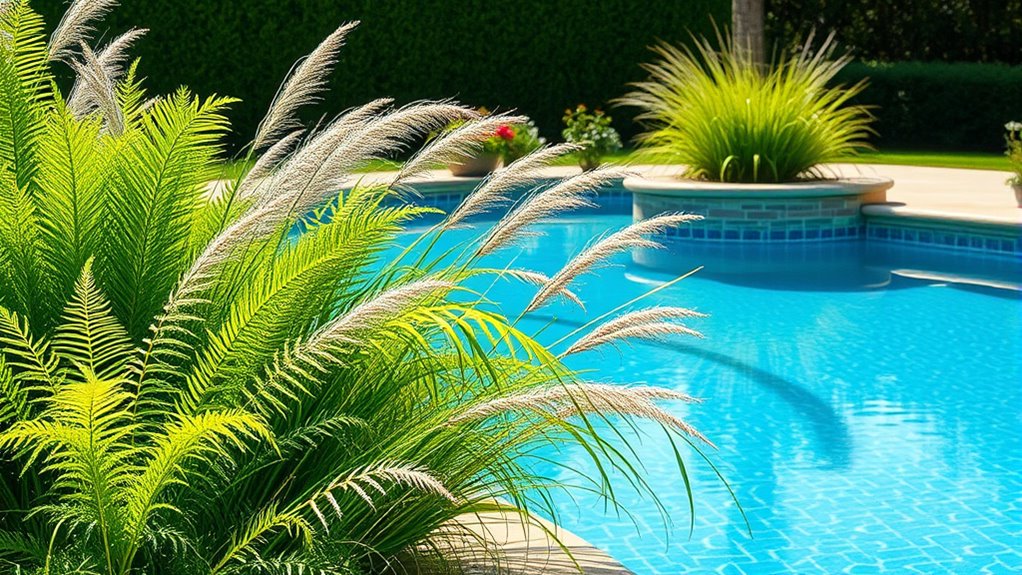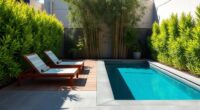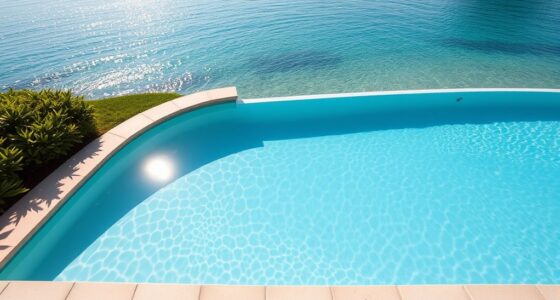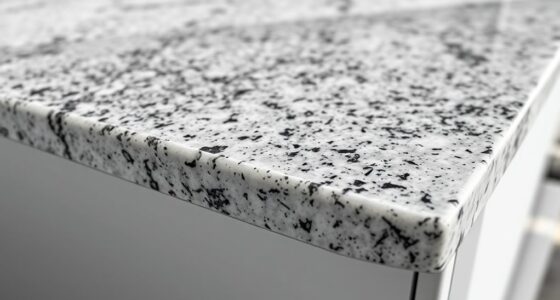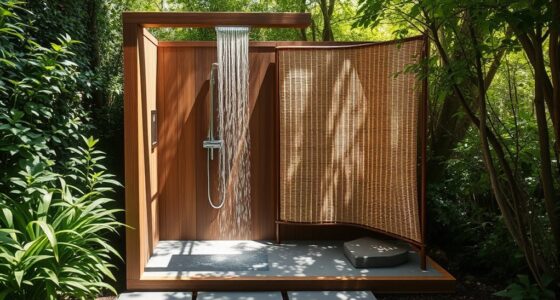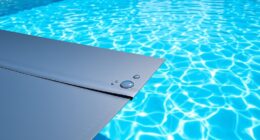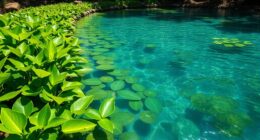To keep your pool filters clear and maintenance low, choose plants that shed little or no debris. Opt for low-maintenance, evergreen shrubs like boxwoods or Yews, and consider dense ground covers such as Japanese Sedge or Ferns. Ornamental grasses like Blue Fescue and drought-resistant succulents are also great options. Trees that provide shade without dropping excessive leaves, like cypress or olive trees, help keep your landscape tidy. Keep exploring for more tips to create a clutter-free pool area.
Key Takeaways
- Choose non-flowering, low-shedding plants like ferns, Japanese sedge, and horsetail reed to prevent debris in filters.
- Opt for dense evergreen shrubs such as boxwoods, yews, and arborvitae for year-round privacy and minimal cleanup.
- Select trees with minimal leaf or needle drop, like conifers, olive trees, and Mediterranean cypress, to reduce debris and maintain filter clarity.
- Incorporate ornamental grasses and low-pollen shrubs like blue fescue and camellia for aesthetic appeal without clogging filters.
- Use drought-resistant plants like succulents and native grasses to minimize watering, debris, and maintenance around pool areas.
Low-Needle Evergreens for Poolside Borders
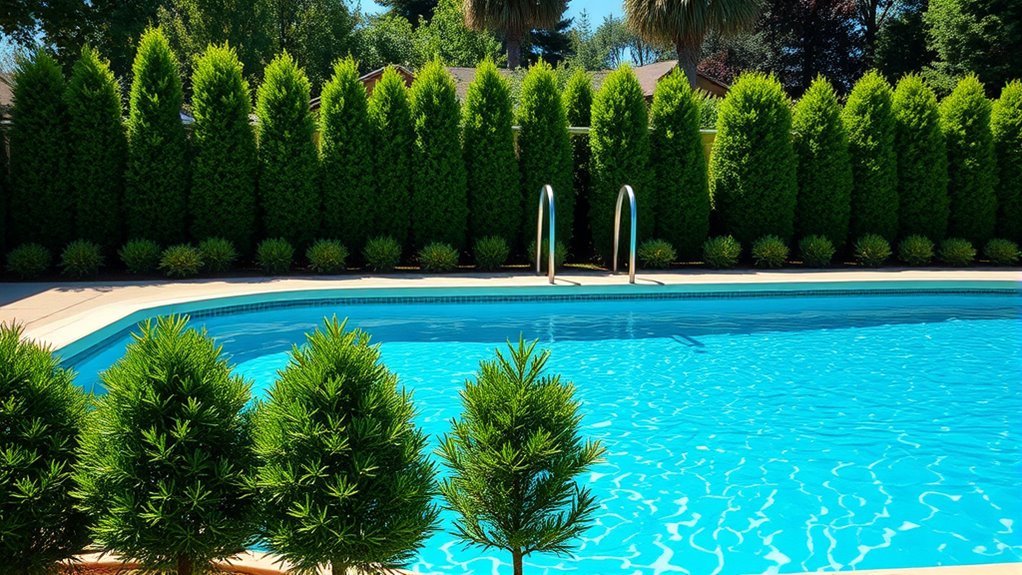
Are low-needle evergreens the right choice for poolside borders? Absolutely. These plants stay compact and maintain a neat appearance year-round, making them ideal for framing your pool area. Because they produce minimal loose needles and debris, they help keep your filters cleaner and reduce maintenance. Varieties like dwarf spruce or juniper provide lush greenery without overwhelming the space. They’re hardy, drought-tolerant, and resist pests, so you won’t need to fuss over them constantly. Plus, their dense foliage offers privacy and a natural barrier against wind. You’ll enjoy a lush, inviting poolside environment that’s easy to care for and stays looking tidy, all without worrying about debris clogging your filters or needing frequent trimming.
Hardy Ground Covers That Minimize Debris

Choosing hardy ground covers for your poolside area can considerably reduce debris and maintenance. These plants stay low and dense, preventing leaves, twigs, and other debris from falling into your pool. Look for options like creeping thyme, which is drought-tolerant and spreads quickly; it forms a dense mat that’s easy to clean. Dwarf mondo grass offers a lush, evergreen carpet that resists foot traffic and drops minimal debris. Sedum varieties are also excellent; they’re hardy, drought-resistant, and rarely shed leaves. These ground covers help keep your pool area tidy without the need for constant raking or vacuuming. Additionally, selecting plants with low-maintenance traits can further reduce your landscape upkeep. Plus, they add natural beauty and stability to your landscape, creating a clean, low-maintenance space for relaxation and recreation.
Ornamental Grasses With Minimal Leaf Drop
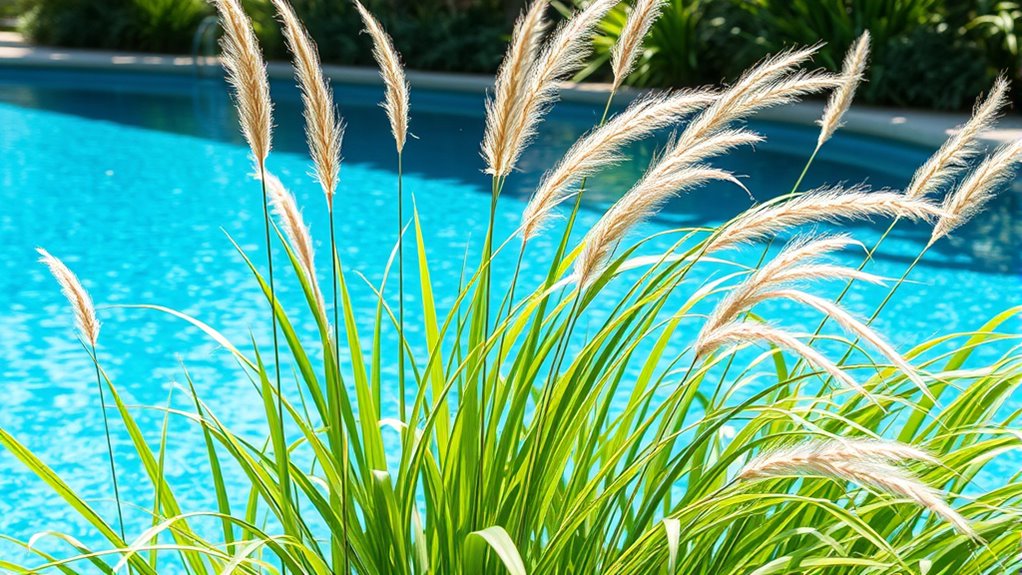
Looking for ornamental grasses that stay tidy around your pool without constant cleanup? Opt for varieties that shed minimally, so you spend less time raking leaves and more time enjoying your space. These grasses add texture and movement without clogging your filters or creating debris. Incorporating healthy eating tips into your landscape planning can also help you maintain a balanced outdoor environment that promotes overall well-being. Here are three top choices:
- Blue Fescue – Compact, drought-tolerant, with blue-gray foliage that stays neat.
- Feather Reed Grass – Upright, stiff leaves that shed little, with tall plumes adding elegance.
- Japanese Forest Grass – Low-maintenance, clumping, with minimal leaf drop and soft green tones.
Choosing these grasses helps maintain a clean pool area while enhancing your landscape’s beauty.
Blooming Shrubs That Keep Mess to a Minimum

Opt for blooming shrubs that produce low pollen and minimal petal shedding to keep your pool area tidy. Look for plants with compact growth habits that stay neat without requiring constant trimming. Choosing these shrubs guarantees vibrant blooms without the mess, making your landscape easier to maintain. Regular plant security measures can further prevent debris from entering your pool area.
Low-Pollen Bloomers
If you want to enjoy a beautiful landscape without the constant cleanup, low-pollen blooming shrubs are an excellent choice. These plants produce minimal airborne pollen, reducing allergy issues and debris around your pool area. They also add vibrant color and texture without overwhelming your filters with mess. Here are three great options:
- Camellia – Blooms in winter or early spring, producing showy flowers with little pollen.
- Azalea – Offers bright, abundant flowers with minimal pollen dispersal.
- Kalmia (Mountain Laurel) – Displays attractive clusters of flowers and releases very little pollen. Choosing these low-pollen shrubs helps keep your pool area cleaner, healthier, and more enjoyable all season long. Additionally, selecting plants with low allergen levels can further enhance the comfort for allergy sufferers during peak pollen seasons.
Minimal Petal Shedding
Choosing shrubs that shed minimal petals can considerably reduce cleanup around your pool. These plants stay tidy, so you spend less time raking and more time enjoying your space. Look for varieties with sturdy blossoms that hold onto their petals longer, like certain hydrangeas or viburnums. To help you select the best options, here’s a quick guide:
| Shrub | Blooming Season | Petal Shedding Level |
|---|---|---|
| Oakleaf Hydrangea | Summer | Low |
| Dwarf Viburnum | Spring-Fall | Minimal |
| Summer-Blooming Spirea | Summer | Moderate |
| Witch Hazel | Fall | Very Low |
Opt for these low-shedding shrubs to keep your pool area clean and inviting. Incorporating plant selection strategies that focus on bloom durability and petal retention can further enhance your landscaping efforts.
Compact Growth Habits
Selecting shrubs with compact growth habits guarantees your pool area stays tidy without constant trimming or cleanup. These plants grow neatly within limited space, reducing debris that can clog filters or clutter your yard. When choosing low-maintenance shrubs, consider their size, shape, and flowering patterns to match your landscape goals. Incorporating efficient landscaping practices can further minimize maintenance needs around your pool. Here are three excellent options:
- Dwarf Spirea – Offers colorful blooms and stays compact, requiring little pruning.
- Boxwood – Provides dense foliage, maintains a tidy appearance, and is easy to shape.
- Dwarf Lilac – Produces fragrant flowers without sprawling or overgrowth.
These plants help you enjoy vibrant, beautiful landscaping while minimizing mess and upkeep around your pool area.
Drought-Resistant Plants Suitable for Pool Areas
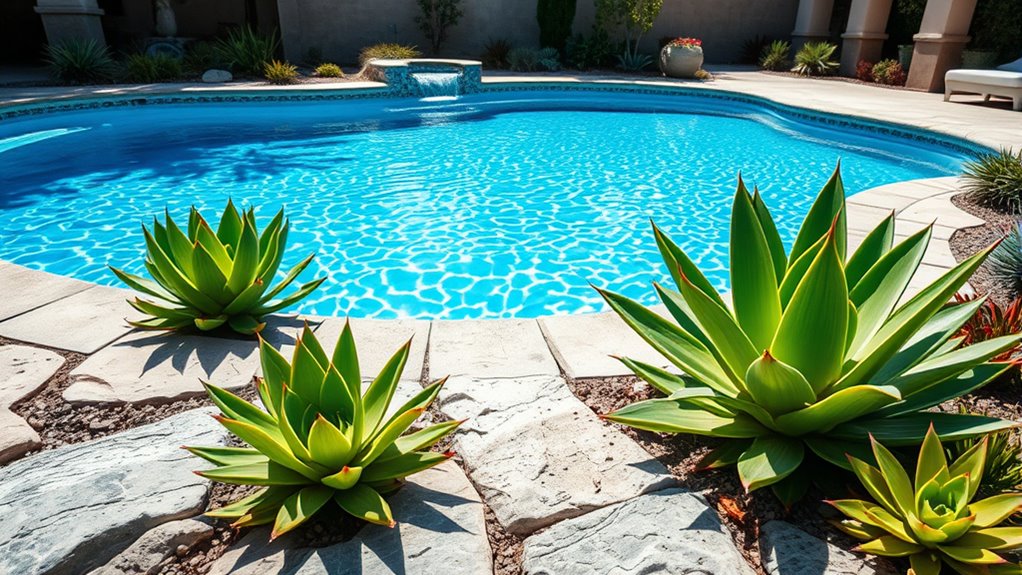
Drought-resistant plants are an excellent choice for pool areas because they require minimal watering and can thrive in dry, sunny conditions. These plants help conserve water while maintaining a vibrant landscape. Succulents like agave, aloe vera, and sedum are perfect options—they store moisture in their leaves and need little attention. Native grasses such as purple muhly or fountain grass add texture without demanding frequent watering. Ornamental shrubs like lavender, rosemary, and sage not only tolerate drought but also release pleasant fragrances. When selecting plants, prioritize those with deep roots and tough foliage to withstand heat and drought stress. Incorporating these hardy plants keeps your poolside landscape lush and sustainable, without clogging filters or demanding excessive maintenance.
Non-Flowering Plants for a Tidy Look

Non-flowering plants can keep your pool area looking neat and low-maintenance. Opt for dense evergreen options or plants with minimal leaf drop to reduce cleanup. These choices give you a tidy landscape that stays attractive year-round without extra effort. Incorporating textile art techniques into your landscape design can also add visual interest and texture to your outdoor space.
Low-Maintenance Foliage Choices
For a tidy, low-maintenance poolside landscape, choosing non-flowering plants that require minimal care can make all the difference. These plants stay neat and healthy with little intervention, reducing upkeep and preventing debris from clogging filters. Consider:
- Horsetail Reed – Its tall, grass-like appearance adds texture without spreading aggressively, and it thrives in wet areas near pools.
- Japanese Sedge – Low-growing and clump-forming, it provides a lush, green ground cover that needs minimal watering and pruning.
- Ferns (like Boston Fern) – They add softness and greenery, tolerate shade, and require only occasional watering.
Additionally, selecting drought-tolerant plants can further simplify landscape maintenance by reducing watering needs and promoting a tidy appearance.
These options give your landscape a clean, polished look while keeping maintenance simple and your pool area clutter-free.
Dense Evergreen Options
Evergreen plants are a smart choice for creating a dense, tidy border that stays lush year-round without the need for frequent pruning or flowering. They provide a consistent backdrop that enhances your pool area’s neat appearance. Options like boxwoods, yews, and arborvitae grow densely, forming a natural barrier that limits debris and keeps your pool cleaner. These plants require minimal maintenance once established, making them ideal for busy outdoor spaces. Their non-flowering nature reduces mess and clutter around the pool, ensuring your landscape remains streamlined. With proper spacing and care, these evergreens can be shaped to fit your desired aesthetic, offering privacy and structure without the fuss of seasonal blooms. Additionally, selecting low-maintenance landscaping plants like these helps minimize environmental impact and ensures a sustainable, attractive poolside environment. Choose dense evergreen options for a reliable, low-maintenance way to define your poolside landscape.
Minimal Leaf Drop Plants
If maintaining a tidy poolside is a priority, choosing plants that shed minimal leaves can make a significant difference. These plants keep your area clean and reduce filter clogging. Consider the following options:
- Boxwood – Its dense foliage stays intact year-round, requiring minimal pruning.
- Japanese Holly – An evergreen shrub with small, glossy leaves that rarely drop.
- Dwarf Conifers – Varieties like junipers and pines retain needles and stay tidy without dropping large amounts of foliage.
- Yew – An evergreen conifer known for its dense, fine-textured foliage that sheds minimally, making it ideal for poolside landscaping. Low-shed foliage provides a neat appearance with less maintenance.
These non-flowering plants provide a clean, low-maintenance landscape. They also add structure and greenery without creating excess debris. Selecting minimal leaf drop plants ensures your pool stays cleaner, saving you time on maintenance while enhancing your outdoor space’s appearance.
Trees That Provide Shade Without Excess Leaf Litter
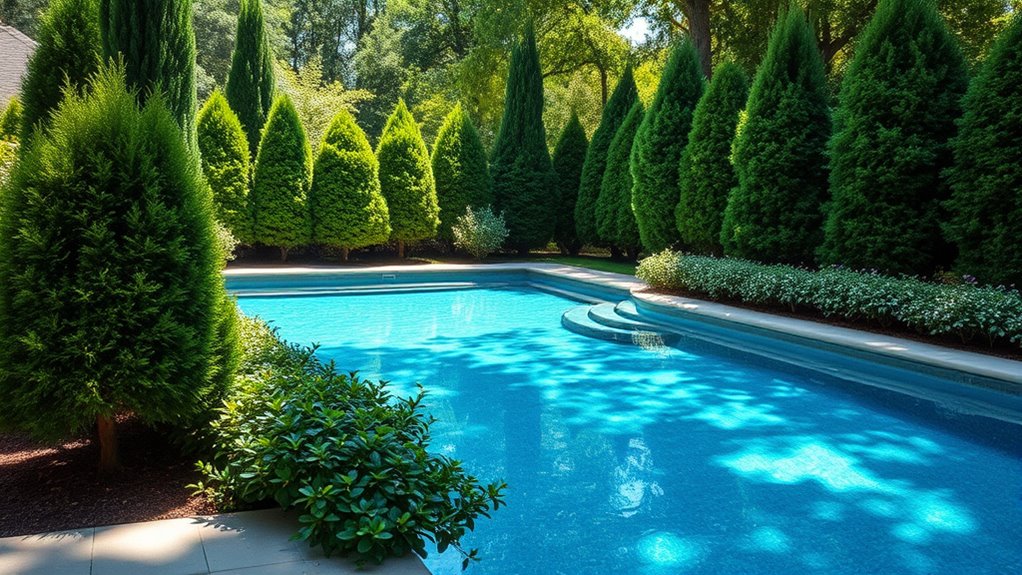
Looking for trees that offer shade without the hassle of constant leaf cleanup? Consider evergreens like pine or cedar—they provide year-round cover and shed minimal debris. Japanese cedar is a great choice, with dense foliage that blocks sun but doesn’t drop large amounts of leaves or needles. Olive trees are also excellent; they provide dappled shade and rarely shed messy foliage, plus they thrive in hot climates. Mediterranean cypress offers vertical shade without the mess, with tiny, scale-like leaves that don’t clog filters. These trees give you the cool comfort you want around your pool area without the ongoing chore of leaf removal. Choose one based on your climate and aesthetic preferences, and enjoy a lush, shaded space that stays clean.
Frequently Asked Questions
Which Plants Are Safest for Pool Chemical Balance?
You should choose plants like bromeliads, ferns, and certain succulents, as they don’t shed大量的叶子 or debris that can clog your pool filters. These plants are also resistant to pool chemicals and won’t affect your water’s pH levels. By selecting non-shedding, hardy plants, you keep your pool cleaner and maintain better chemical balance, making your swimming experience safer and more enjoyable.
How Often Should I Prune Poolside Plants to Reduce Debris?
You should prune your poolside plants every 2 to 4 weeks, especially during the growing season, to minimize debris. Did you know that falling leaves and plant debris account for nearly 70% of pool filter blockages? Regular pruning keeps your pool cleaner, reduces filter strain, and maintains water quality. Keep an eye on your plants, and trim them proactively to enjoy crystal-clear water with less maintenance.
Are There Any Plants That Naturally Repel Insects Near Pools?
Yes, you can plant insect-repelling plants near your pool to keep bugs away. Consider lavender, citronella, marigolds, and basil, which naturally repel mosquitoes and other pests. These plants not only help create a bug-free zone but also add beauty and fragrance to your poolside area. Make sure to place them strategically around the perimeter to maximize their effectiveness and enjoy a more relaxing, pest-free swimming experience.
What Maintenance Routines Are Recommended for Low-Debris Landscaping?
Think of your landscaping as a well-oiled machine—smooth and efficient. To keep it that way, regularly trim plants to prevent excess debris, sweep leaves from pool surfaces, and clear gutters and drains. Water your plants early in the day to avoid sogginess, and prune dead or overgrown branches monthly. Consistent upkeep guarantees your yard stays tidy, reducing debris getting into filters and keeping your pool sparkling clean.
Can Native Plants Reduce Landscaping Upkeep Around Pools?
Yes, native plants can reduce your landscaping upkeep around pools. They’re adapted to your local climate, so they require less watering, fertilizing, and pruning. This means less debris falling into your pool and fewer maintenance tasks. Plus, native plants often attract beneficial insects and support local ecosystems, creating a beautiful, sustainable landscape that’s easier to maintain and less likely to clog your filters.
Conclusion
By choosing the right plants for your poolside, you can turn your outdoor space into a pristine retreat. Think of your garden as a silent guardian, quietly working to keep debris at bay while enhancing your view. With these low-maintenance, clog-resistant options, you’ll enjoy scenic beauty without the hassle. After all, isn’t a tranquil, clutter-free pool area worth the thoughtful choice of plants that work with you, not against you?
